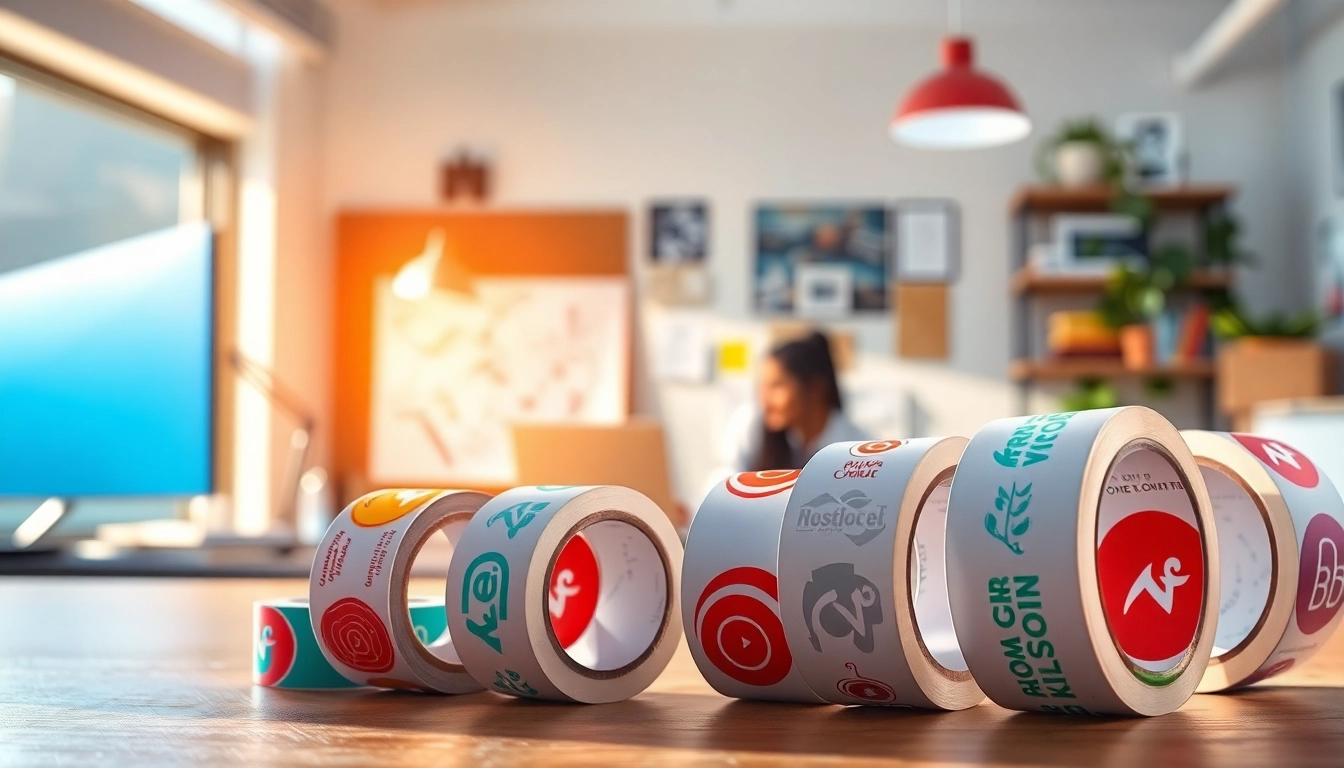Understanding Custom Tape Options
Types of Custom Tape Available
In the world of packaging and branding, custom tape has emerged as an essential tool for businesses aiming to communicate their brand identity effectively. The variety of custom tape types available provides businesses with options that cater to their specific needs. The most common types include:
- Printed Hazard Tape: This type features safety or caution messages, primarily used in industrial settings to alert employees about hazards.
- Clear Packing Tape: Often used for general packaging, this tape can be customized with logos or messages while allowing the contents to remain visible.
- Paper Tape: Eco-friendly and customizable, this type of tape works well for those looking to project a sustainable brand image.
- Polypropylene Tape: Known for its strength and durability, polypropylene tape can support heavier packages and comes in various colors for customization.
- Kraft Tape: Made from natural paper, this tape is adhesive and can be printed with designs or logos, suitable for eco-conscious businesses.
Each type serves a unique purpose, making it crucial for businesses to choose wisely based on their specific packaging and branding needs.
Evaluating Quality and Material
When selecting custom tape, evaluating the quality and materials is paramount. High-quality tapes ensure packages are securely sealed, while also representing the brand effectively. Here are some factors to consider:
- Adhesive Strength: A strong adhesive ensures durability, especially when shipping items. For heavier products, a tape with high tensile strength is essential.
- Material Type: Depending on the packaging environment, businesses may prefer paper, PVC, polypropylene, or eco-friendly materials. Each has different durability and aesthetic properties.
- Print Quality: Vibrant, crisp prints help capture the attention of customers. Ensure the supplier uses advanced printing technologies for high-quality output.
Factors Influencing Custom Tape Choices
Selecting the right custom tape involves several influencing factors, including:
- Target Audience: Knowing the audience can help determine the appropriate design and tape type.
- Shipping Conditions: For long-distance shipping, heavier-duty tapes are more suitable.
- Environmental Considerations: Many consumers prefer eco-friendly options, influencing businesses to consider sustainable materials.
By evaluating these factors, businesses can make informed decisions about their custom tape needs.
Benefits of Using Custom Tape for Branding
Enhancing Brand Awareness
Custom tape is an excellent way to enhance brand awareness. Every package shipped or delivered bears the company’s logo and custom design, serving as a mobile advertisement for the business. Customers who receive packages with customized tape are likely to take notice, increasing the likelihood of brand recall. Some effective methods to utilize custom tape for brand awareness include:
- Utilizing eye-catching designs that capture attention.
- Incorporating promotional messages or campaign themes.
- Using colors and aesthetics that align with the brand’s identity.
Improving Packaging Security
Aside from branding, custom tape plays a crucial role in securing packages. A strong, well-adhered tape reduces the risk of package tampering, creating trust with customers. Quality custom tape can withstand various shipping conditions, ensuring that contents remain intact during transit. This aspect of security also extends to protecting sensitive information, as custom tape can be designed to indicate whether a package has been tampered with.
Cost-Effective Marketing Solutions
Investing in custom tape can be cost-effective compared to other marketing strategies. It serves multiple functions: securing packages while also delivering a branding message. Businesses can believe in the efficiency of placing an ad directly onto their shipping materials without extra costs. Moreover, custom tape can lead to reduced marketing and advertising expenses by becoming a part of the overall packaging strategy.
Designing Your Custom Tape
Best Practices for Artwork Submission
When designing custom tape, it’s crucial to follow best practices for artwork submission to ensure the best results. Effective artwork can make a significant difference in how the brand is perceived. Here’s how to achieve superior outcomes:
- High-Resolution Images: Always submit high-resolution images to prevent pixelation and maintain print quality.
- Vector Files: If applicable, submit vector files (like AI or EPS formats) as they can scale without losing quality.
- Safe Zones: Design with safe zones in mind; avoid placing crucial content at the edges where it may be cut off during the production process.
Selecting Colors and Materials
The selection of colors and materials impacts the overall effectiveness of custom tape. Consider the following:
- Color Theory: Understand how colors communicate messages and emotions. Choose colors that resonate with your brand identity.
- Material Reflectivity: Consider how different materials will interact with light and colors; matte finishes can lend a certain premium touch, while glossy finishes can be vibrant.
Incorporating Branding Elements Effectively
Incorporating branding elements into custom tape should be seamless and aesthetically pleasing. A few strategies to accomplish this include:
- Logo Placement: Position your logo prominently but tastefully, preferably at regular intervals across the tape.
- Consistent Typography: Use font styles and typography that align with your overall branding for consistency.
- Tagline or Slogan: Consider including a catchy tagline that reinforces the brand message or evokes emotional connection.
How to Order Custom Tape
Choosing the Right Supplier
Selecting the right supplier for custom tape is crucial for ensuring quality and timely delivery. Research potential suppliers by checking:
- Reviews and Testimonials: Explore previous customer experiences to gauge the supplier’s reliability.
- Sample Products: Request samples to assess the quality of the tape and printing.
- Customer Support: Ensure they have accessible customer support to facilitate smooth communication.
Understanding Pricing Structures
When it comes to pricing, various factors affect the cost of custom tape, including:
- Order Volume: Larger orders often come with lower per-unit pricing due to economies of scale.
- Material Choices: Different materials vary in cost; thus, your selected type of tape will impact pricing.
- Design Complexity: Complex designs may incur additional charges due to production requirements.
Streamlining the Ordering Process
To ensure a smooth ordering experience, focus on streamlining the process by:
- Preparing Artwork Early: Have your design ready before beginning correspondence with the supplier.
- Utilizing Online Tools: Many suppliers offer online design tools or templates, which can simplify the designing and ordering process.
- Establishing Communication Channels: Keep open lines of communication for updates or clarifications during the order process.
Maximizing the Impact of Custom Tape
Using Custom Tape for Promotions
Custom tape can be an effective promotional tool for special events, product launches, or limited-time offers. Businesses can utilize season-specific designs or promotional messaging to attract attention during specific times of the year. This will not only enhance customer interest but also encourage sharing on social media, leading to further reach without additional marketing costs.
Integrating Custom Tape into Marketing Strategies
To create a cohesive marketing strategy, integrate custom tape into broader promotional efforts. This may include:
- Launching New Products: Packaging new products with distinctive custom tape to signify their uniqueness.
- Brand Collaborations: Teams from different brands could utilize co-branded custom tape, expanding market reach and engagement.
- Social Media Campaigns: Encourage customers to share their unboxing experiences featuring the custom tape on social media platforms, boosting organic reach.
Measuring Success and Feedback
Finally, measuring the success of custom tape initiatives is essential for future enhancements. Businesses can gather insights by:
- Tracking Customer Engagement: Gauge how customers respond to packages via social media interactions or direct feedback.
- Analyzing Sales Data: Compare sales before and after implementing custom tape to gauge impact on conversion rates.
- Collecting Customer Feedback: Utilize surveys or feedback forms to gather insights from customers about their perceptions of the packaging.
In conclusion, custom tape is not just an accessory in packaging; it’s an integral component of branding that offers numerous benefits, from enhancing brand visibility to ensuring product security. By understanding the various options, designing effectively, and integrating custom tape into marketing strategies, businesses can leverage this powerful tool for growth and recognition in an increasingly competitive marketplace.



